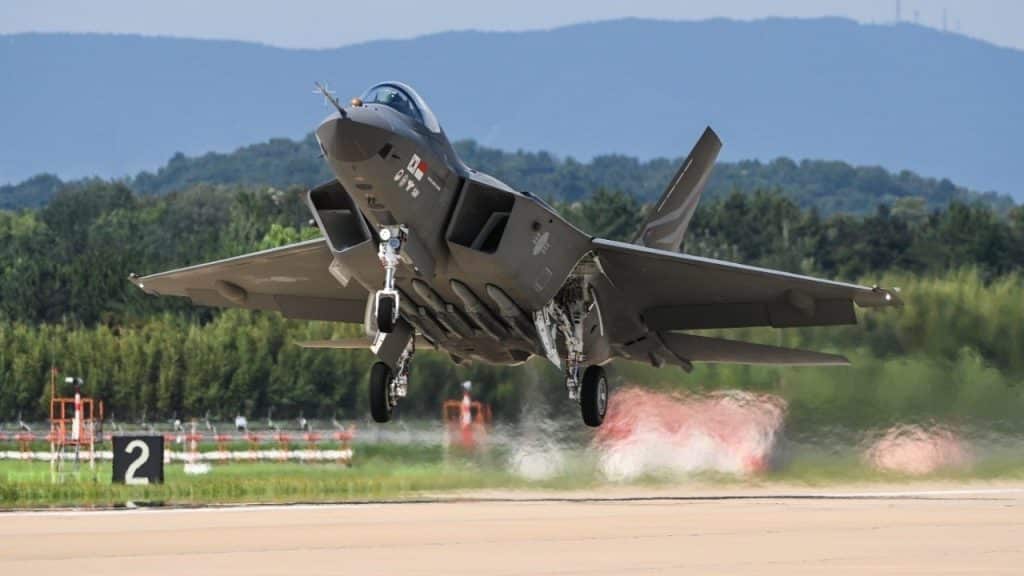South Korean news agency Yonhap reported that after a nearly four-year break, the Indonesian government resumed charges to cover the costs of developing the KF-21 Boramae combat aircraft. The previous payment was recorded in January 2019. The resumption of fees is probably related to the Indo Defense Expo & Forum exhibition in Jakarta, which will be held on November 2-5. According to the agreement between both countries, Indonesia is to finance 20% of the development costs of the fighter IF-X there.
Yonhap, citing an anonymous source, reports that Jakarta transferred 9.4 billion won (31.6 million zlotys) on November 1. However, it is a drop in the ocean. It is unofficially known that Indonesian arrears have already exceeded 800 billion won. The cost of the entire program was originally estimated at 8.8 trillion won (29.6 billion zlotys), but a year ago the cost estimate shrank to 8.1 trillion won thanks to a bit of creative accounting. The South Korean government classified KF-21 as a “defense article”, which exempted the project from VAT.
As we have written many times, Indonesia has proved to be a troublesome partner for Seoul. The delays in paying the fees due began practically immediately after the conclusion of the agreement. The aforementioned transfer in January 2019 amounted to 130 billion won. Indonesia’s previous financial contribution to KF-X / IF-X was recorded in 2017. The head of the Korean military procurement agency DAPA said that Jakarta covers 30% of its liabilities by deliveries of unspecified goods.
The Indonesian Ministry of Defense has repeatedly stated that it does not intend to give up participation in the development of the fighter, but a rather liberal approach to the payment schedule meant that the entire program was expected to die soon. Worse still, the agreement does not provide for any penalties or ways to recover outstanding payments. In addition, Indonesia reduced the original order from eighty to fifty aircraft.
Part of the IF-X is to be produced locally and thus contribute to the development of the Indonesian aviation industry. Maintaining cooperation and ordering, even truncated, is also of importance to KAI, which is thinking of selling KF-21 in Southeast Asia.
/ 15 🇰🇷 Korea Aerospace Industries #KAI
-KF-21 Boramae
-FA-50 #LCA
-KT-1 Basic Trainer Aircraft
-LAH Light Armed Helo
-KUH-1 Utility Helo # IndoDefence2022 #ROKAF pic.twitter.com/qW7C1BMrhC– JATOSINT (@Jatosint) November 4, 2022
A new fighter program to replace the obsolete Phantoms II and Tiger II was announced in 2001. The following year, the South Korean Joint Staff Committee presented its initial requirements. Indonesia joined the program – then known as KF-X – in 2010. The requirements for KF-X were very ambitious and many observers said the project would fail. In fact, the program underwent numerous ups, downs and dramatic twists before the final contract for developing a fighter was signed with KAI in December 2015.
The KF-21 circled made its first flight on July 19 this year. The plane took off at 3.40 pm local time. The flight was successful, Boramae landed after just over half an hour in the air. The machine was tested at the South Korean Air Force’s 3rd School Wing base at Sacheon, approximately 300 kilometers south of Seoul. In this city there are KAI plants, where KF-21 is being built.
DAPA officially identifies the KF-21 as a 4.5 generation combat aircraft. Previously, the fighter was among the fifth generation, especially in the South Korean media. There is nothing surprising about it, from the very beginning the Koreans tried to present their fighter as an alternative to the F-35, although it had weaker performance and worse stealth properties, but it was definitely cheaper. It is very likely that future versions will be more advanced in all respects: detection limitations, net-centricity, and possibly a propulsion capable of reaching supersonic speed without the use of afterburners.
In September this year, KAI also presented the KF-21N on-board version. Visible changes compared to the land version are limited to folding wings and hook. The on-board fighter is also to be slightly larger. According to the information obtained by Naval News, at the current stage, the project involves extending the fuselage from 16.9 meters to 17.1 meters and the span from 11.2 meters to 12.3 meters. It is not yet known whether the KF-21N will take off with a catapult (CATOBAR) or a starting hill (STOBAR). It all depends on the final design of the carrier.
🇰🇷KAI KF-21N (Navy) for Korean CVX Aircraft Carrier Project pic.twitter.com/nqp28DYGVR
– Hyunmin Park (@HyunminPppp) September 21, 2022
See also: New versions of Chinese ballistic anti-ship missiles
the Ministry of Defense of the Republic of Korea

